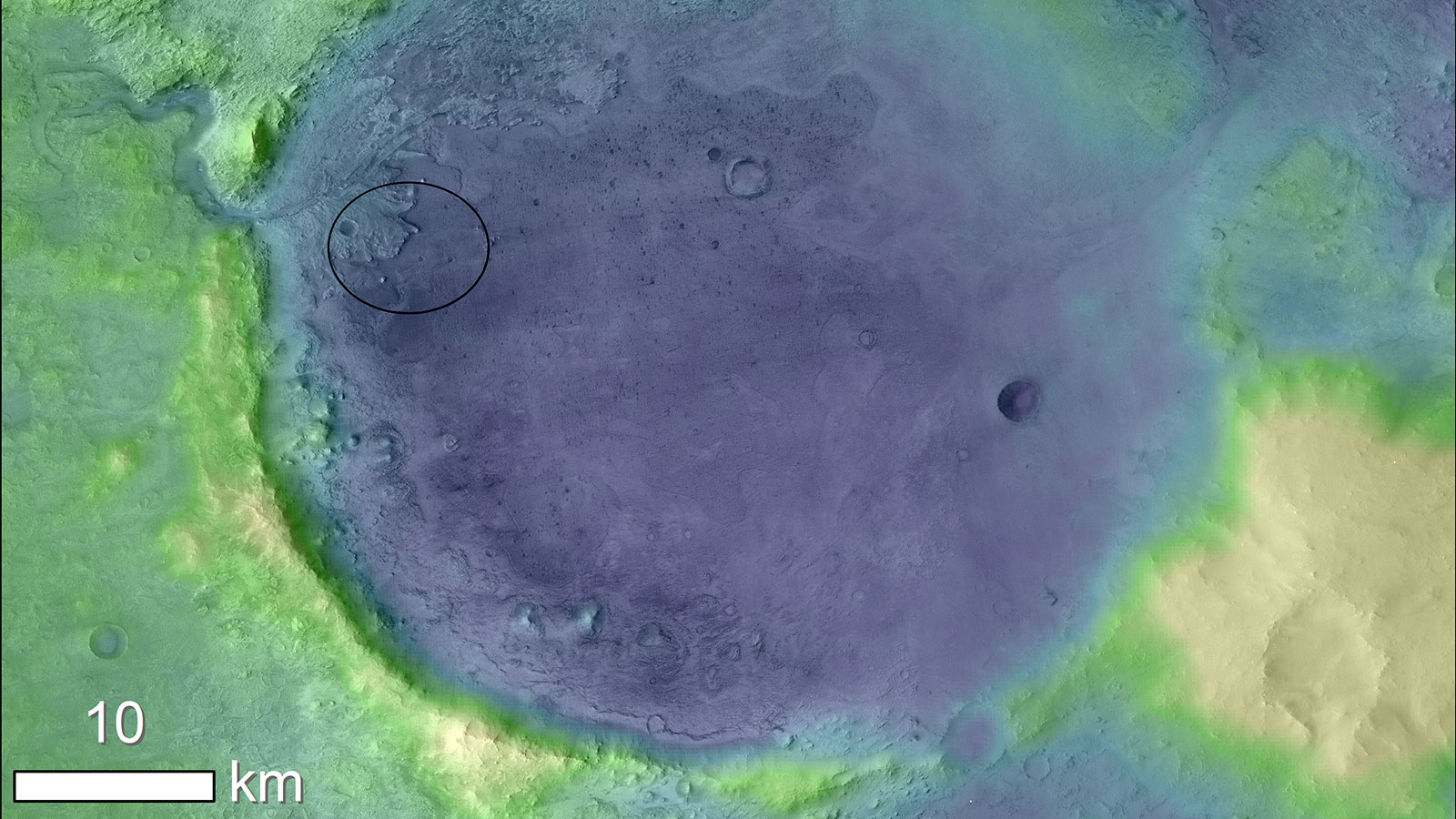
The life-hunting grounds could be pretty rich for NASA's next Mars rover.
Jezero Crater, the 28-mile-wide (45 kilometers) hole in the ground that the Mars 2020 rover will begin exploring in February 2021, has ample deposits of minerals that are good at preserving microfossils here on Earth, two new studies have found.
One of those minerals is hydrated silica. After poring over data gathered by the Compact Reconnaissance Imaging Spectrometer for Mars (CRISM) instrument aboard NASA's Mars Reconnaissance Orbiter, a team of researchers identified two Jezero outcrops that are rich in the stuff, Jesse Tarnas and colleagues reported this month in the journal Geophysical Research Letters.
Related: NASA's Mars Rover 2020 Mission in Pictures
"We know from Earth that this mineral phase is exceptional at preserving microfossils and other biosignatures, so that makes these outcrops exciting targets for the rover to explore," Tarnas, a Ph.D. student in planetary science at Brown University, said in a statement.
Just like the 96-mile-wide (154 km) Gale Crater, which NASA's Curiosity Mars rover has been exploring since August 2012, Jezero apparently hosted a lake in the ancient past. Orbital imagery has also revealed the remnants of a large delta in Jezero, which marks where a river drained into the lake.
Deltas are good areas to search for signs of life, because these regions concentrate deposits from all over a river system. Indeed, the presence of a delta is one of the reasons NASA chose Jezero as the Mars 2020 landing site.
Get the Space.com Newsletter
Breaking space news, the latest updates on rocket launches, skywatching events and more!
One of the newfound hydrated silica outcrops lies at the edge of the Jezero delta at low elevation, Tarnas and his team found. If the minerals formed where they now lie — which is no guarantee, since the material could have been washed in from afar — they may represent the delta's lowest layer.
"The material that forms the bottom layer of a delta is sometimes the most productive in terms of preserving biosignatures," co-author Jack Mustard, a professor of Earth, environmental and planetary sciences at Brown (and a professor of environmental studies there as well), said in the same statement. "So, if you can find that bottomset layer, and that layer has a lot of silica in it, that’s a double bonus."
In the other new study, which was published online Monday (Nov. 11) in the journal Icarus, a different team of researchers used CRISM data to identify a "bathtub ring" of carbonate minerals in Jezero. Here on Earth, organisms use carbonates — minerals that contain the carbonate ion, CO3 — to build sturdy structures that can survive for billions of years in fossil form. Seashells, for example, are made of calcium carbonate.
"CRISM spotted carbonates here years ago, but we only recently noticed how concentrated they are right where a lakeshore would be," study lead author Briony Horgan, an assistant professor of planetary science at Purdue University in Indiana, said in a different statement.
"We're going to encounter carbonate deposits in many locations throughout the mission, but the bathtub ring will be one of the most exciting places to visit," Horgan added.
Again, the carbonates' history is unclear; it's unknown when they formed. But the Mars 2020 team is excited by the prospect that the carbonates were deposited when water sloshed in Jezero Crater.
"Carbonate chemistry on an ancient lakeshore is a fantastic recipe for preserving records of ancient life and climate," Mars 2020 deputy project scientist Ken Williford, of NASA's Jet Propulsion Laboratory in Pasadena, California, said in the statement. (JPL leads the Mars 2020 mission.) "We're eager to get to the surface and discover how these carbonates formed."
Carbonates themselves aren't biosignatures; there are many different types, and most of them have nothing to do with life. But carbonate minerals form via the interaction of carbon dioxide and liquid water, so studying their presence and abundance could help reveal insights about Mars' long-ago transition from a relatively warm and wet world to the cold desert planet that it is today, researchers said.
Mars 2020, which will soon get a new moniker via a student naming competition, is scheduled to launch in July 2020 and arrive on Jezero's floor on Feb. 18, 2021. Another life-hunting Mars rover, the European-Russian robot Rosalind Franklin, will hit the red dirt in another, yet-to-be-announced location at around the same time.
- Mars 2020: The Red Planet's Next Rover
- Life on Mars: Exploration & Evidence
- Photos: Ancient Mars Lake Could Have Supported Life
Mike Wall's book about the search for alien life, "Out There" (Grand Central Publishing, 2018; illustrated by Karl Tate), is out now. Follow him on Twitter @michaeldwall. Follow us on Twitter @Spacedotcom or Facebook.

Join our Space Forums to keep talking space on the latest missions, night sky and more! And if you have a news tip, correction or comment, let us know at: community@space.com.

Michael Wall is a Senior Space Writer with Space.com and joined the team in 2010. He primarily covers exoplanets, spaceflight and military space, but has been known to dabble in the space art beat. His book about the search for alien life, "Out There," was published on Nov. 13, 2018. Before becoming a science writer, Michael worked as a herpetologist and wildlife biologist. He has a Ph.D. in evolutionary biology from the University of Sydney, Australia, a bachelor's degree from the University of Arizona, and a graduate certificate in science writing from the University of California, Santa Cruz. To find out what his latest project is, you can follow Michael on Twitter.









